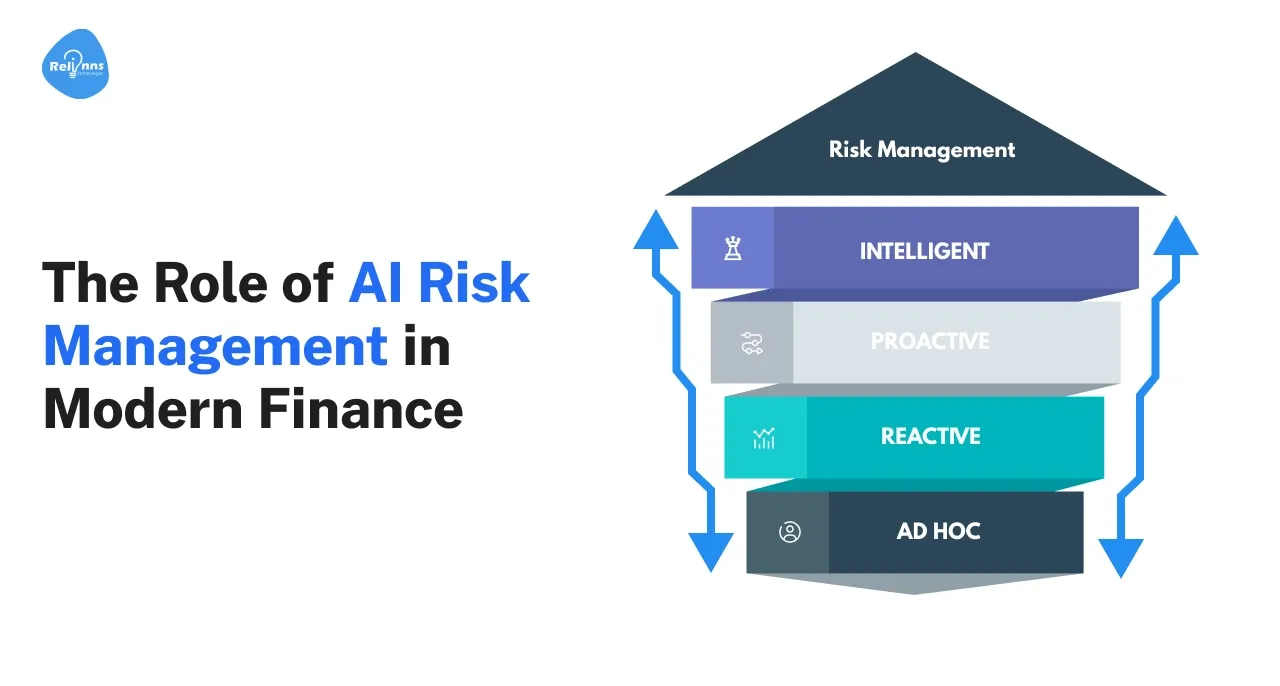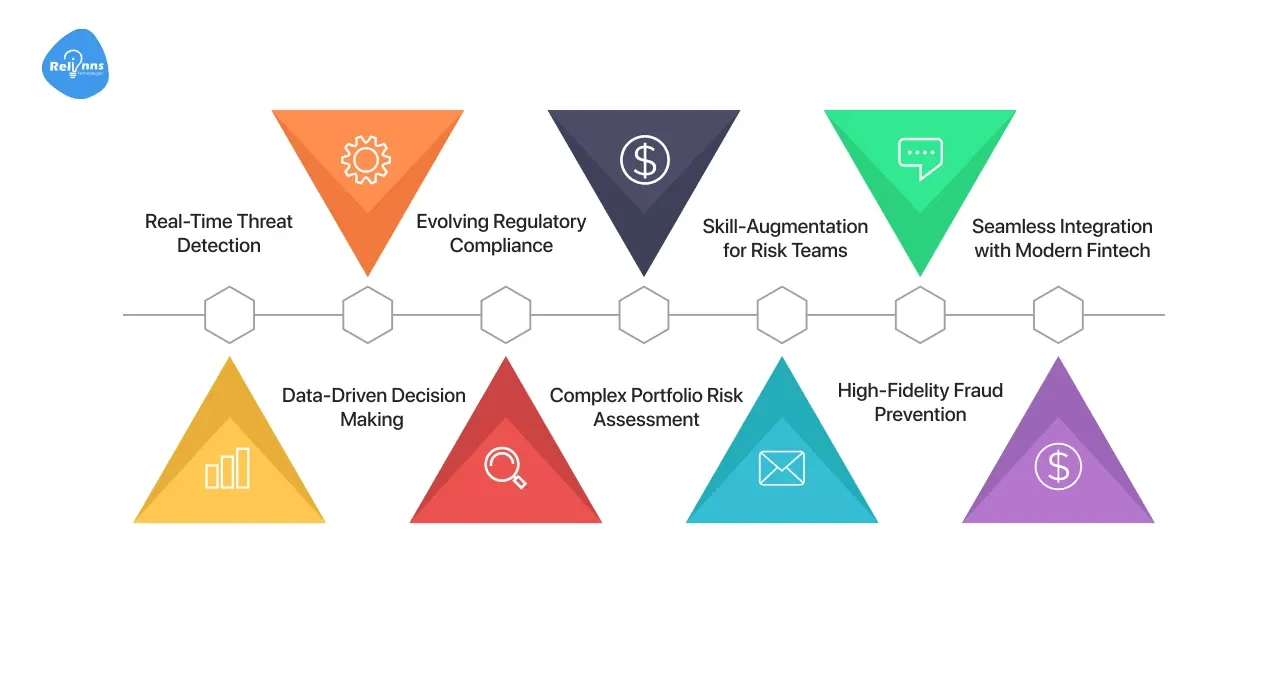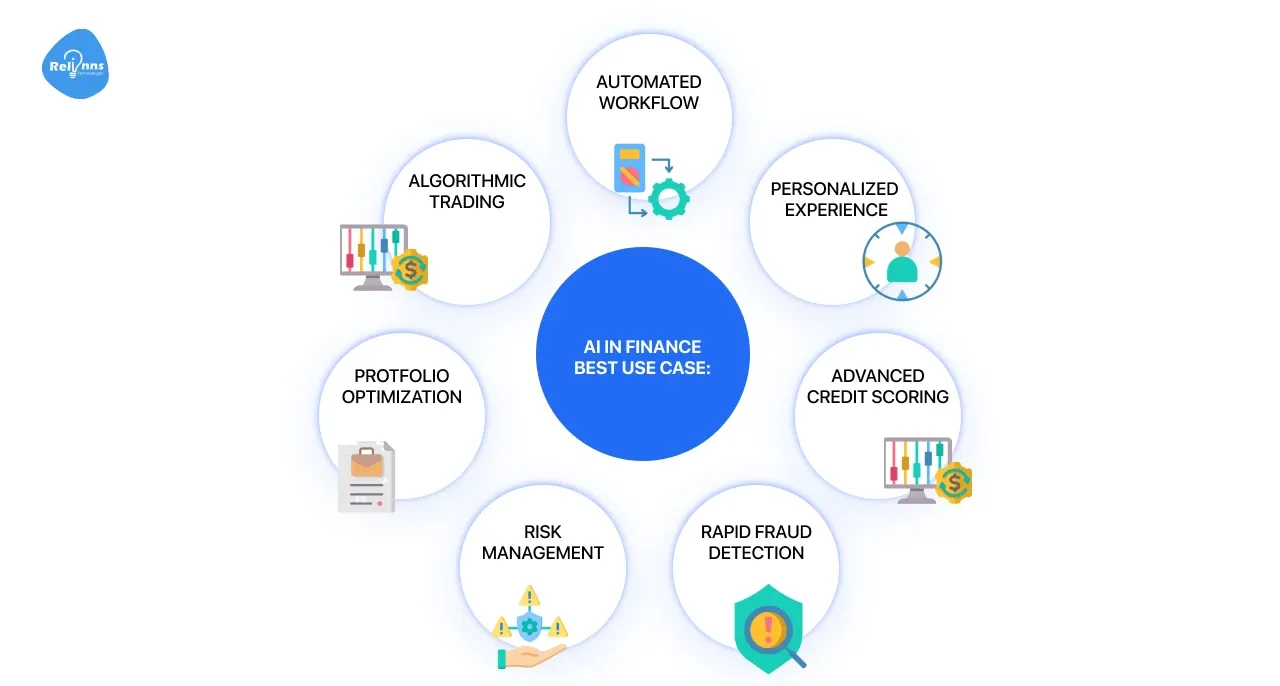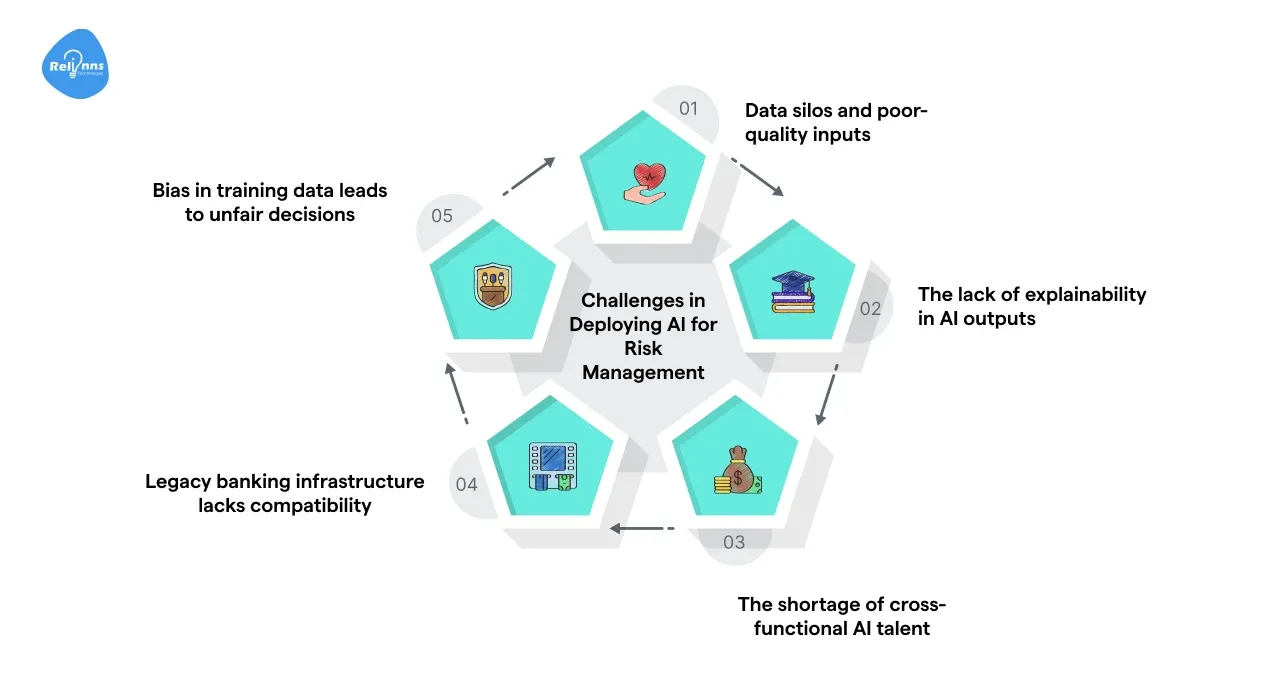The Role of AI Risk Management in Modern Finance
Date
Nov 08, 25
Reading Time
13 Minutes
Category
Generative AI

Risk in financial services is no longer slow-moving or predictable. Complexity, real-time digital payments, rising fraud vectors, regulatory flux, and increased consumer scrutiny define the modern finance ecosystem.
In this environment, AI risk management has emerged as a vital strategy, enabling institutions to shift from reactive defense to predictive, real-time control.
With tools like generative AI for risk management, banks and insurers can simulate risk scenarios, detect anomalies, and auto-generate compliance reports with unprecedented speed and scale.
As the industry leans into AI for risk management in finance, it’s not just about survival; it’s about gaining a competitive edge through smarter, data-driven decisions. This article explores the frameworks, benefits, and real-world applications of AI in today’s risk workflows, offering insights for leaders navigating tomorrow’s financial challenges.
Understanding AI Risk Management in Modern Finance
AI risk management isn’t just a tech trend; it’s a fundamental shift in how financial institutions detect, analyze, and respond to threats.
In the past, risk teams relied on periodic reports, manual reviews, and lagging indicators to make decisions. But today, real-time insights are critical. With the explosion of digital transactions, fraud vectors, and compliance mandates, traditional methods simply fall short.
That’s where AI comes in.
By combining machine learning, predictive analytics, and big data, financial institutions can now spot anomalies in milliseconds, proactively flag suspicious behavior, and simulate threats before they occur.
AI for risk management in finance allows decision-makers to take faster, smarter actions backed by massive data analysis, all while reducing manual workloads.
- 91% of global banks use AI for at least one risk management function.
- Fraud detection via AI has improved threat identification accuracy by 37%.
- AI in bank risk management reduces loan approval times by 50%.
Why Financial Institutions Need AI for Risk Control
The global financial system today operates in an environment defined by speed, volatility, and unpredictability.
Every second, trillions of dollars move through international payment systems, online banking portals, and trading platforms. With such velocity comes vulnerability to fraud, data breaches, human error, and systemic risk.
In this reality, AI risk management has become more than an efficiency tool; it is the new foundation of financial resilience.
AI for risk management in finance isn’t about replacing humans; it’s about extending their capabilities. Machine learning models detect subtle anomalies that might precede fraud, credit defaults, or insider breaches.
And generative AI for risk management can simulate complex market scenarios or automatically generate compliance reports that once took analysts days to produce.
The outcome? Financial institutions that deploy AI experience measurable improvements in performance, customer trust, and regulatory standing.
- 73% of banks say AI has helped them anticipate and mitigate risks earlier in the cycle.
- 88% of financial institutions report faster risk identification across multiple categories, from credit to compliance.
- AI-driven analytics cut fraud response times by 60%, protecting billions in assets each year.
- Generative AI now drafts over 30% of internal audit and compliance summaries in top-tier institutions.
In a world where risk is dynamic and data is limitless, AI is no longer optional; it is essential for survival. Financial organizations that integrate these systems today aren’t just managing risk; they’re mastering it.
Why & When to Use AI Risk Management in Finance
 Some risks can’t wait for a quarterly review.
Some risks can’t wait for a quarterly review.
That’s why AI risk management exists to bring real-time adaptability, predictive accuracy, and intelligent automation to a financial world that evolves by the hour. It’s ideal when data volumes are massive, threats are dynamic, and regulatory expectations are non-negotiable.
Let’s explore where and why AI becomes indispensable in financial risk workflows.
A. Real-Time Threat Detection
AI excels in high-speed environments, such as payments and trading.
It detects fraud, insider threats, or transaction anomalies in milliseconds, enabling a proactive response rather than a delayed reaction.
B. Data-Driven Decision Making
When decisions must consider millions of data points, AI becomes the only scalable option.
AI for risk management in finance uses structured and unstructured data to offer risk insights, forecasts, and next-step recommendations.
C. Evolving Regulatory Compliance
Regulatory frameworks like Basel III, GDPR, and KYC evolve constantly.
Generative AI for risk management adapts quickly, auto-generates audit reports, and summarizes policy changes with precision and speed.
Suggested Reading: AI in KYC Automation
D. Complex Portfolio Risk Assessment
Risk managers need to test “what-if” scenarios across thousands of loans, trades, or claims.
AI enables stress testing, dynamic portfolio simulations, and macroeconomic modeling without waiting for manual reports.
E. Skill-Augmentation for Risk Teams
Skilled human analysts are critical, but they’re limited in speed and scope.
AI extends its capabilities by handling repetitive analysis, surfacing insights, and ensuring nothing slips through the cracks.
F. High-Fidelity Fraud Prevention
In domains like insurance claims, wire transfers, or credit card usage, fraud patterns evolve daily.
AI models continuously retrain using live data, outperforming static rule-based filters by wide margins.
G. Seamless Integration with Modern Fintech
AI integrates easily with existing systems, including low-code platforms, cloud-based analytics tools, and payment gateways.
This ensures faster rollout, smoother adoption, and continuous risk coverage across every digital touchpoint.
AI risk management is built for speed, scalability, and smart decision support, but it works best when paired with the right talent, infrastructure, and data governance.
Core Technologies Powering AI Risk Management
Behind every intelligent risk decision lies a powerful stack of AI technologies.
From detecting fraud in milliseconds to predicting credit defaults, modern systems rely on machine learning, deep learning, and natural language processing to deliver precision at scale.
These technologies form the foundation of AI risk management, enabling financial institutions to respond faster, smarter, and more securely.
A. Machine Learning (ML)
Machine learning is the brain behind modern AI systems in finance.
It processes large volumes of historical data, learns risk patterns, and adapts in real time to new threats. ML helps predict defaults, fraud, and even system outages with remarkable speed and accuracy.
- Learns from structured data, such as transaction history and behavioral risk indicators.
- Enables fraud detection systems to adapt continuously to evolving attack patterns.
- Reduces credit decision time by up to 50% in top-performing banks.
B. Deep Learning (Neural Networks)
Deep learning handles highly complex and nonlinear data relationships.
These neural networks mimic the human brain and are effective in sequential, high-volume financial applications such as fraud detection and biometric security.
- Powers anti-fraud systems by recognizing complex, time-based transaction behavior.
- Used in American Express for real-time fraud alerts under 2 milliseconds.
- Boosted risk model performance by 39% vs traditional ML tools, especially in high-risk cases.
C. Natural Language Processing (NLP)
NLP allows AI systems to read, analyze, and act on unstructured data.
In finance, this includes contracts, emails, regulatory notices, and complaint logs, which are often ignored by traditional systems.
- Automates review of regulatory texts, client contracts, and internal audit logs.
- Flagged misconduct in employee chats and emails during internal fraud investigations.
- Reduced compliance document review time by 60%, saving hundreds of analyst hours.
D. Generative AI
Generative AI creates, not just predicts.
In risk management, it’s used to generate reports, simulate events, and even build synthetic data for safer model training, speeding up tasks that once took days.
- Simulates market crashes or customer defaults for better stress testing.
- Draft risk summaries, audit memos, and regulatory disclosures instantly.
- Increased reporting output by 3×, with audit-ready quality in large U.S. institutions.
E. Predictive Analytics
Predictive analytics forecasts future risk events before they occur.
These models are trained on historic and real-time data to highlight hidden patterns, helping teams take preventive action with confidence.
- Flags potential credit, operational, or cyber risks days before actual events.
- Forecasts SME loan defaults with up to 88% accuracy using behavioral trends.
- Helped reduce unexpected loss events by 32% in mid-sized banks.
F. Anomaly Detection Engines
These engines specialize in spotting unusual behavior.
From AML to fraud to access abuse, anomaly detection tools continuously learn what “normal” looks like and flag anything that doesn’t fit the pattern.
- Detects deviations in location, transaction velocity, or device use.
- Prevented multi-million-dollar fraud in cross-border banking by catching invisible anomalies.
- Decreased false positives by 42% compared to static, rule-based systems.
G. Explainable AI (XAI)
Explainable AI turns black-box decisions into clear, transparent outputs.
Especially important in regulated sectors, XAI enables banks to explain why a loan was denied or a transaction flagged, improving trust and compliance.
- Breaks down AI outputs into readable factors, such as credit history or the income-to-debt ratio.
- Required in 67% of AI lending and fraud platforms for audit compliance.
- Enabled banks to pass regulatory audits with zero model opacity issues reported.
Real-World Use Cases of AI in Financial Risk Management
 Real-world results are the most evident proof of AI’s power in finance.
Real-world results are the most evident proof of AI’s power in finance.
Across banking, insurance, and payments, leading institutions are using AI risk management to drive measurable impact from fraud prevention and underwriting to healthcare claims and wire transfers.
These examples demonstrate how AI for risk management in finance is not only feasible but also highly effective.
Relinns Technologies – Joget-Powered AI Risk Dashboard for NBFCs
Problem: A fast-scaling NBFC (Non-Banking Financial Company) in India struggled with scattered risk data across silos. Their risk officers manually pulled reports from spreadsheets, payment systems, and third-party APIs, wasting time and increasing the risk of missed fraud signals, delayed compliance alerts, and poor credit visibility.
Solution: Relinns built a Joget-based AI risk management platform for the client. It unified credit scores, fraud detection flags, and payment behavior into a centralized dashboard. The solution leveraged machine learning to assess borrower risk and generative AI to auto-draft loan memos and audit responses, all accessible via a mobile-friendly interface.
Results
- Reduced monthly reporting workload by 68% through automation of data gathering and formatting.
- Decreased loan processing delays by 41% using AI-powered borrower scoring and approval logic.
- Improved fraud alert accuracy by 34%, with auto-escalation via rule-based AI triggers.
- Cut compliance reporting time from 3 days to 6 hours using generative AI modules.
See more here: Relinns AI-Powered Contract Management System
American Express – Real-Time AI Fraud Detection
Problem: American Express processes billions of global transactions, but legacy rule-based fraud detection couldn’t keep up with sophisticated, evolving attack patterns. Delays in analysis led to false positives, customer friction, and missed fraud events across its massive cardholder base.
Solution: AmEx deployed deep learning models using LSTM (Long Short-Term Memory) networks accelerated by NVIDIA GPUs. The AI system scanned transaction behavior in real time, scoring threats in under 2 milliseconds and enabling proactive fraud blocking without slowing down customer experience.
Results
- Achieved 50× processing speed using GPU-powered deep learning over legacy models.
- Reduced false declines by 43%, improving customer retention and satisfaction.
- Detected 60% more high-risk transaction chains in real time.
- Secured over 8 billion annual transactions with 99.99% accuracy.
See more here: NVIDIA x American Express
Challenges in Deploying AI for Risk Management

Despite its transformative potential, deploying AI in risk environments poses significant hurdles.
From infrastructure limitations to model transparency, institutions must address technical, ethical, and operational concerns before scaling solutions.
Understanding these challenges helps ensure safer, fairer, and more effective adoption of AI risk management.
- Data silos and poor-quality inputs limit AI’s learning capability, slow model training, and often result in inconsistent, fragmented risk visibility across departments and systems.
- The lack of explainability in AI outputs makes it difficult for banks to justify risk decisions, comply with audits, or meet evolving global regulatory transparency standards.
- The shortage of cross-functional AI talent, those skilled in both finance and data science, slows adoption, weakens models, and increases the risk of implementation failure.
- Legacy banking infrastructure lacks compatibility with AI models, resulting in long deployment cycles, integration roadblocks, and reduced scalability of AI across workflows.
- Bias in training data leads to unfair decisions, especially in credit or fraud models, raising ethical concerns, compliance flags, and long-term reputational damage.
Conclusion: Mastering Risk Starts with Smarter Systems
The future of financial stability lies in intelligent, adaptive, and scalable risk frameworks. As fraud tactics evolve, regulations tighten, and transactions accelerate, AI risk management offers the speed and sophistication financial institutions need to stay ahead.
From credit decisions to real-time fraud monitoring, AI isn't just streamlining workflows and transforming outcomes.
Institutions that deploy AI for risk management in finance now benefit from sharper insights, faster responses, and fewer operational bottlenecks.
And with generative AI use cases in financial services expanding rapidly, automation is no longer limited to detection; it now enables decision-making, documentation, and simulation at scale.
This is where Relinns Technologies makes a measurable difference.
With deep expertise in low-code platforms like Joget and end-to-end AI implementation, Relinns helps financial institutions build compliant, explainable, and scalable AI risk systems faster and smarter.
Why Choose Relinns for AI Risk Solutions?
- 40% faster implementation of AI workflows using low-code and pre-trained modules.
- 60% average reduction in manual reporting time with Joget-integrated AI dashboards.
- Real-time alerting and scoring engines tailored for credit, fraud, and compliance risks.
- 24/7 global support, explainable AI models, and secure cloud-native architecture.
Frequently Asked Questions (FAQ's)
How does AI risk management support ESG compliance in finance?
AI risk management helps banks monitor environmental, social, and governance (ESG) risks by analyzing sustainability disclosures, reputational data, and regulatory updates, enabling ESG-aligned credit scoring and portfolio strategy.
Can generative AI help reduce operational risk in banking systems?
Yes, generative AI for risk management identifies workflow inefficiencies, generates test cases, and auto-drafts SOPs, helping banks reduce manual errors, tech bottlenecks, and regulatory delays across operations.
What are the everyday use cases of AI in insurance risk management?
AI for risk management in finance also powers insurance risk functions, detecting claim fraud, predicting underwriting risks, automating policy reviews, and estimating natural disaster exposure using predictive analytics.
How is AI used for real-time credit risk monitoring in trading platforms?
AI risk management tools continuously analyze trade flows, margin levels, and counterparty exposure, giving risk officers real-time alerts during volatility or market disruptions, especially in high-frequency trading environments.
Is AI in bank risk management secure and compliant with global laws?
Leading solutions follow GDPR, CCPA, and Basel IV. AI in bank risk management uses explainable models, encrypted data lakes, and audit-ready logs to ensure governance and regulatory confidence.


